My contribution to the recent Jutland Aeronef refight was a division of German battleships – specifically the 5th Division of the 3rd Battle Squadron, consisting of the SMS Koenig, Grosser Kurfurst, Kronprinz and Markgraf. Since we had pretty much free reign over what models we used, as long as they looked the part (there were some heavily modified Russian Borodinos as part of the German fleet !) I chose to use some of our Prussian ships, the Konigsberg and Manteuffel, modifying and painting two of each. I also painted two von Dobschutz cruisers and four Wavre frigates, although in the end they didn’t make the table.
I’ve always been very impressed by the conversion work that Jon Rogers did on his US and Japanese fleets for his Pacific Aeronef game, with additional turrets, funnels, masts and rigging, and wanted to attempt something similar. To this end, I created a bunch of turrets, new funnels, masts, AA guns, searchlights and ventilators and ships boats as 3D models and had them printed by Shapeways. As is always the way, these then sat in a box for months until I finally got round to starting the build !
The first job was a quick cleanup of the casts, removing any flash – the Prussian models are pretty clean casts and this didn’t take long. The next job was to remove all of the funnels on the larger vessels, as these were to be replaced by new plastic ones. I then turned the models over and superglued a washer underneath – the models were to be ‘flown’ on magnetic flight stands so they needed the steel washer as an attachment.
Now it was time to start adding the detail parts. All of the main and secondary turrets were replaced by new plastic models of a different design to the metal ones usually supplied with the models. They are based on the design of the German Brandenburg class pre-dreadnoughts, essentially a hemisphere with a large bustle. I mixed single and twin turrets on the ships, and added some extras on empty areas of deck – the Manteuffels in particular got a third main turret instead of the normal two.
Funnels were also replaced – the new plastic ones were slightly larger, so the Konigsbergs received one while the Manteuffels got two. New pole masts with a fighting top were added, with thinner topmasts and crossbeams made from cut up paperclips (which I figured would be a lot more robust than having such thin pieces 3D printed). I added some ship’s boats to the Manteuffels – unfortunately there wasn’t room for any on the Konisbergs. I also liberally dotted searchlights and small AA guns around the superstructures, but in the end I didn’t use the ventilators. The last addition was some large vertical tail fins from plasticard, glued under the existing tails (there are some handy beams to attach these to).
Once built, all of the models were undercoated with white Halfords automotive primer. The hulls were painted with a Tamiya dark grey and the superstructure mid sea grey. The grey areas were drybrushed with Games Workshop Longbeard Grey, then the whole lot was washed in GW Nuln Oil, which looked good but unfortunately dulled the difference between the two greys – so next time I’d use a lighter grey for the superstructure. The decks were painted Tamiya Buff and washed in Gryphonne Sepia – the wash does a great job of picking out the deck planking and also hides a multitude of sins in terms of less-than-straight edges. A quick drybrush of GW Terminatus Stone accentuated the deck detail. After that I went round and did a bit of tidying up where deck paint had got onto the hull sides and superstructure.
The last bits of the paint were pretty straightforward – funnels were painted dark red and highlighted, with black tops (German battleships had their aft funnels painted red at Jutland), searchlights picked out with yellow faces, masts and boats painted in shades of brown and windows/portholes blue, with GW washes where appropriate. The tail fins of the battleships got a red stripe and Dom’s Decals used for the crosses.
At this point the models were painted and I was able to varnish them using Army Painter matt anti-shine varnish from a spray can. They were ready for the last stages of flags and rigging – but I decided to add some more detail. Jon had added rigged torpedo net-style spars to his ships and I decided I liked the look of that. I’d finished the build earlier than expected (I was surprised how quickly it went) so still had time to go back and add extra details. I drilled out equally spaced holes in the hull sides using a dremel and inserted lengths of paperclip wire. The ends of the were were filed flat to remove any sharp points – as you can see from the rather gruesome photo below, paperclip wire can be sharp when cut… The beams were then quickly painted and washed – I didn’t bother with undercoat or varnish but it all looks OK.
Rigging was done with cotton thread. I found the trick with this was to cut an overlong piece and attach it securely with superglue, and only then start wrapping it round the other beams and spars. The thread was wrapped round each beam and a tiny dot of superglue used to secure it (I used a very narrow applicator that came with some pound shop bottles). Once the glue had all dried I touched a drop of sepia wash around each knot on the rigging to dull down any shiny or fogged glue.
And that was it – I think they looked the business on table, and in fact three of them were some of the few surviving German ships at the end of the game – they fought well and took down several enemy vessels including HMS Barham, one of the largest British ships of the time.
The detailing kit I used is now available on Shapeways – it’s not too expensive (£30 or so) and there are enough parts for half-a-dozen large ships or more smaller ones.
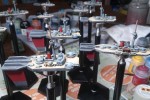
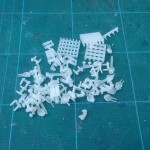

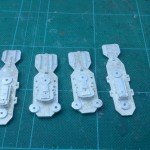
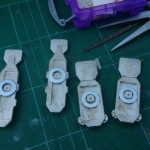
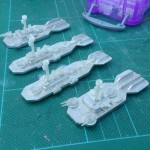
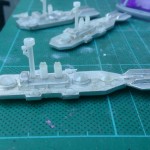
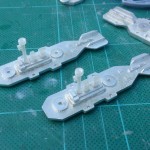

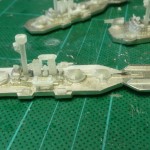
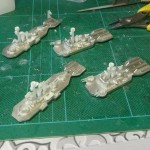
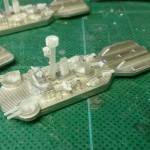
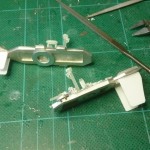
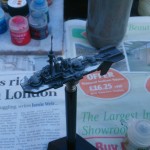
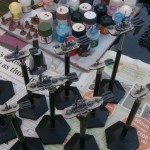
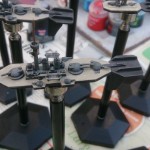
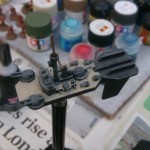

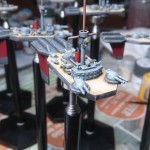
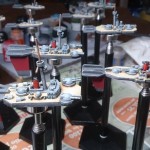
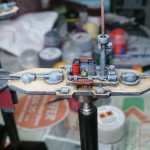
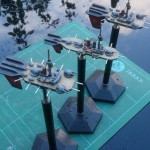
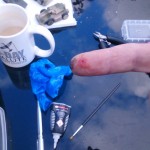


Very nice! I always enjoy the posts for Aeronef and Land Ironclads!